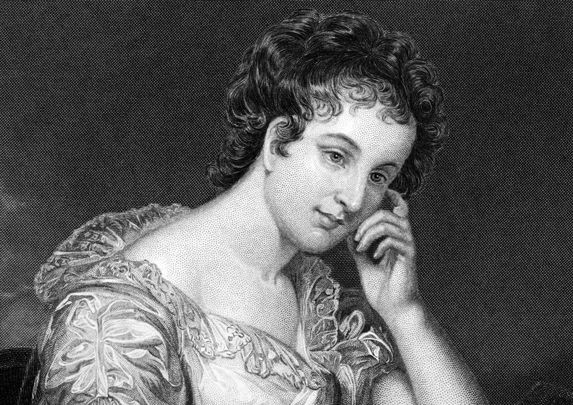Edgeworthstown is a wonderful heritage location tucked away in the heart of Ireland’s landlocked county of Longford. Like many places in the Midlands, it is best appreciated through the story of its history and the remarkable people who resided here. None more so than Maria Edgeworth, pioneering children’s writer, novelist, and educational thinker.
Maria Edgeworth lived through some of the most turbulent times in Ireland, including the 1798 Rebellion and the Great Famine of the 1840s. The town takes its name from her family who owned extensive lands and estates in the area. The Edgeworths were typical Anglo-Irish gentry who owned the ‘big houses’ of Ireland and had tremendous power over the livelihoods of their tenants who worked the numerous small farms of their demesnes.
It’s easy to over-simplify 18th-century Irish history. The population was divided between the oppressed, largely uneducated Irish peasantry and the land-owning aristocracy. This was a time of privilege and inequality when penal laws severely constrained Catholic ownership and access to professions. Many landlords regarded their estates purely as a source of income and cared little for the impact of their actions on the lives of their tenants. They were despised by the local communities.
However, some Anglo-Irish families, including the Edgeworths, saw themselves as Irish and worked for the betterment of the lives of local people. They sought to improve the country through agriculture, science and building projects. Organizations like the Royal Dublin Society, established in 1731, paved the way for modern farming methods and improved transport and infrastructure. These families remained royalist and rich, while genuinely empathising with the plight of the local people who lived among them.
It’s hard to appreciate how progressive and ground-breaking it was for a woman writer to emerge from the relative obscurity of middle Ireland at that time. In 1798, in collaboration with her father, Maria Edgeworth published a book called Practical Education in which she outlined her innovative approach to child development. The publication was immensely popular in Britain and Europe and translated into many languages. The book introduced several pioneering ideas on children’s education such as the importance of observing the child and how they see the world, the role of play and imagination, and the need for structured practice to develop skills. These innovations combined with her ‘practical’ approach provided a useful guidebook for parents when there was nothing else comparable.

Maria Edgeworth Center.
1798 was the same year the United Irishmen led a bloody rebellion in the southeast and a force of French soldiers landed in the west of Ireland. The French and supporting Irish rebels were finally defeated at Ballinamuck, only a few miles from Edgeworthstown. Against all this turmoil and very real danger for a family like the Edgeworths, they remained unscathed, and their house and lands were untouched by the rebels.
As a young woman Maria accompanied her father in managing the affairs of the Edgeworth estate and through these interactions, she came to know and respect the character of the local people. She was critical of the attitudes of fellow landowners and her most famous novel "Castle Rackrent", published in 1800, satirized her own class and the cruel practices of tenant estates. This novel and many of her subsequent publications sought to represent ‘Hibernian Tales’ and did much to raise the consciousness of readers in England and elsewhere of the qualities of the Irish and their way of life.

Looking for Irish book recommendations or to meet with others who share your love for Irish literature? Join IrishCentral’s Book Club on Facebook and enjoy our book-loving community.
Maria’s interest in education was stimulated by her father who married four times and had 22 children over his lifetime. She was educated in England up to her fifteenth year, when she eventually joined her father at the family home in Ireland. As Maria was the eldest child in the household, she had plenty of first-hand experience of bringing up the other children (20 in all). In addition to her novels, letters, and education publications, she also wrote books and stories for children. These were unusual for a time when childhood imagination was regarded as something to be managed rather than nurtured.
Edgeworth’s stories and fictional writings, be they for adults or children, were always imbued with a sense of purpose and morality. With titles like "Lazy Lawrence", "Simple Susan", "Forgive and Forget" and "Waste Not Want Not" it is easy to see how her children’s stories carried a moral message of the right and proper way to behave.

A bust of Maria Edgeworth outside the Maria Edgeworth Center.
Perhaps the most enduring legacy of the Edgeworths, both father and daughter, was their early advocacy for the establishment of a formal education system in Ireland. Through the late 17 and early 1800s, they encouraged the authorities to establish a public school system for boys and girls and all denominations. Eventually, through a mechanism known as the Stanley Letter of 1831, a national school system was established across the country, well in advance of most other countries at the time including England. National schools remain the backbone of Irish primary school system to this day.
Maria Edgeworth died in 1849, her final publication was a children’s story called Orlandino distributed in the America to raise funds for the plight of famine victims in Ireland. Throughout her life she was a prolific letter writer, novelist, playwright, social influencer, and educator. As a woman and member of the Anglo-Irish elite she managed to break with the expectations of her class and demonstrate what could be achieved through insight, compassion, and persuasion. Hew approach was a powerful counterpoint to the wars and rebellions that prevailed at the time.
Today’s Edgeworthstown is still honoring the legacy of its most famous resident. A new modern library adorns the main street, and the Maria Edgeworth Interpretative Centre is an additional attraction for the town. Local historian Matt Farrell and colleagues in the Edgeworth Society continue to promote awareness of her writings and her life and times in the area. It’s well worth taking the trouble to go there and see the school-preserved classrooms, artifacts and first editions of her books.
Her legacy lives also in the continuation of Ireland’s passion for education. In the 19th and 20th centuries, Irish educators were at the forefront of the establishment of many schools and colleges across the world. The work continues to this day. I would like to think this is due in no small way to influence of a small woman with a pen who wrote tirelessly and demonstrated through how learning and stories provide better pathways to future success and prosperity.
I’ll leave the final word to Maria herself and her famous quotation “If we take care of the moments the years will take care of themselves”.
* Maria Edgeworth Visitor Centre is at MariaEdgeworthCenter.com.




Comments